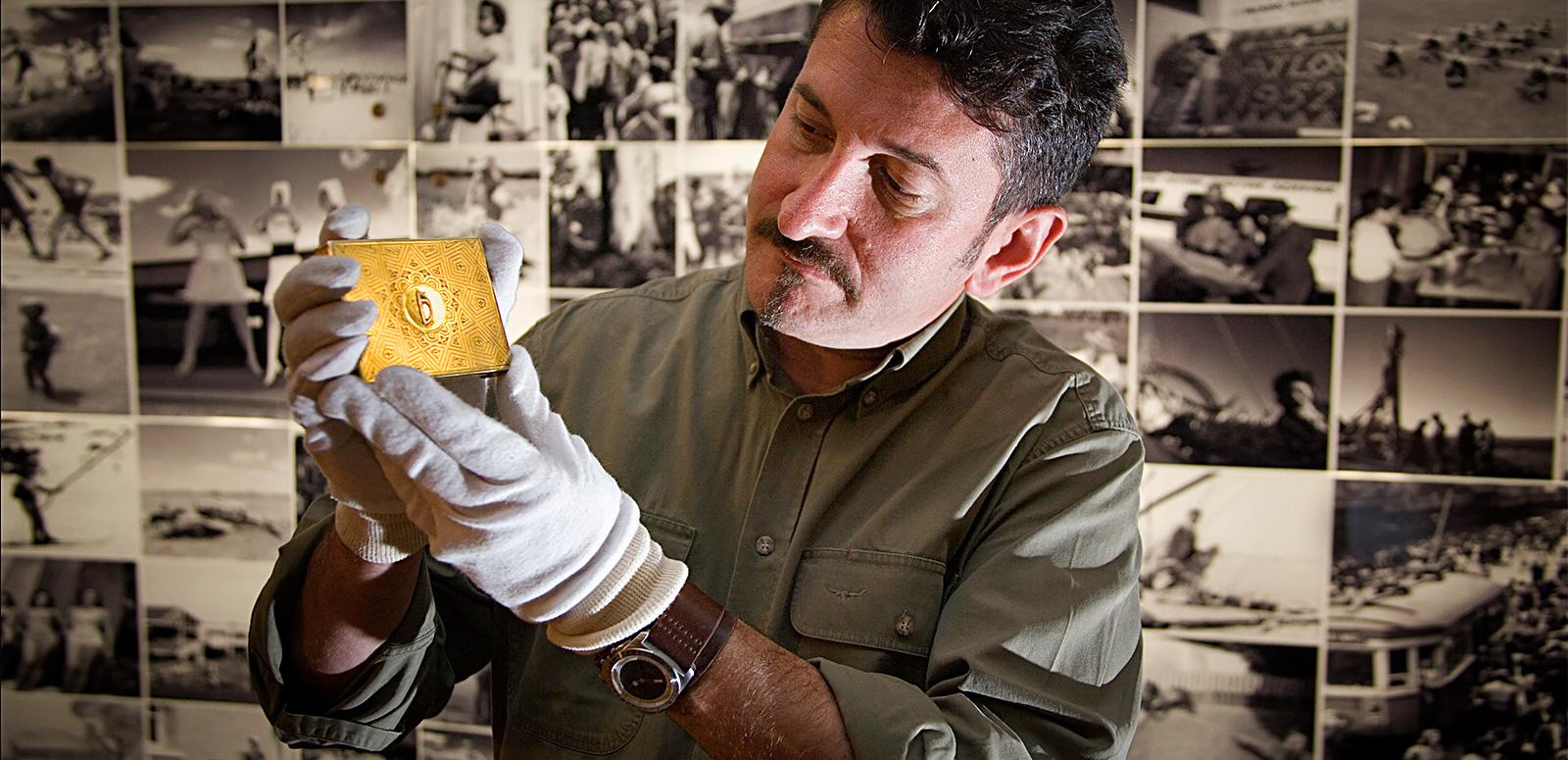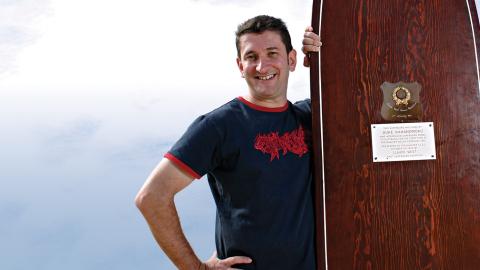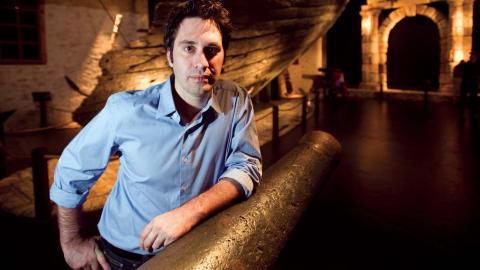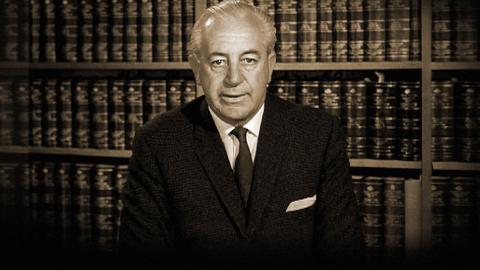
Plan your visit
Around the web
Contact
Email sign up
Never miss a moment. Stories, news and experiences celebrating Australia's audiovisual culture direct to your inbox.
Donate
Support us to grow, preserve and share our collection of more than 100 years of film, sound, broadcast and games by making a financial donation. If you’d like to donate an item to the collection, you can do so via our collection offer form.

The Prime Ministers' National Treasures
The Prime Ministers' National Treasures with Warren Brown
Warren Brown reveals the emotional lives of Australian prime ministers through 12 objects they used every day or otherwise adored.
Items include Robert Menzies' home movie camera, Joseph Lyons' love letters, Harold Holt's briefcase and Ben Chifley's pipe.
The award-winning political cartoonist, columnist and history 'tragic' spotlights 12 treasures drawn from public and private collections across Australia in this second season of five-minute National Treasures documentaries.
The Prime Ministers' National Treasures collection is based on the Film Australia National Interest Program produced in association with Old Parliament House and the Australian Broadcasting Corporation.
See also Investigating National Treasures with Warren Brown and Australia's Heritage: National Treasures.
Andrew Fisher’s tin lunch box reminds us that humble beginnings informed his formidable political career.
Leaving school at ten, he was a coal miner throughout his teens, and migrated to Australia from Scotland at 23. He rose quickly from union organiser to three-time Prime Minister, inventing the Australian ideal of a ‘fair go’ along the way.
Among a host of policies designed for the common good, he advocated maternity allowances and greater political equality for women.
Andrew Fisher (1862–1928) was Prime Minister of Australia three times: from November 1908 to June 1909, April 1910 to June 1913 and September 1914 to October 1915. He is regarded as one of the most successful Australian politicians.
Andrew Fisher’s lunch box is held at the Gympie Gold Mining Museum in Queensland.
The Prime Ministers' National Treasures is also available for purchase from the NFSA Online Shop.
During the First World War Australian soldiers fought on the Western Front. This was Australia’s main war involvement, far bigger than the fighting at Gallipoli in 1915.
Australians fought in the war as fellow members of the British Empire – with the Australian Government not hesitating to consider Australia also at war when Britain declared war on Germany.
In 1916 the Australian Government, under Prime Minister William Morris (Billy) Hughes, called for conscription of Australian men to supply replacements for the war casualties; voluntary recruiting did not seem to be producing sufficient numbers to supply the front line.
'The Little Digger', as Hughes became known, held a referendum (really a plebiscite, a popular vote that indicated people’s opinions, but was not able to change the Constitution) in which the people of Australia had to indicate whether they supported or opposed conscription. The referendum caused great divisions in Australian society and within Hughes’ own governing Australian Labor Party. The referendum was very narrowly defeated.
In December 1917 Hughes, who by this time had been expelled from the Labor Party for his advocacy of conscription and was now the leader of the Nationalist Party (a combination of the pro-conscription Laborites and the Liberal Party), held a second referendum. A slightly increased majority rejected the proposal, but with great social hostility and disruption being caused by the issue.
The irascible Hughes was a popular and dynamic politician despite a tendency to feud. He worked with 100 secretaries during his term in office, helped found the Labor party, the Nationalist Party, and the United Australia Party and was ousted from all three.
He formed the Commonwealth Police Force after a dissenter socked him with an egg during a conscription campaign and the state police force did nothing.
William Hughes (1862–1952) was Prime Minister of Australia from October 1915 to February 1923, and a member of the Commonwealth Parliament from the first sitting in 1901 until his death in 1952. The 1916 conscription badge is held at the Powerhouse Museum in Sydney.
The Prime Ministers' National Treasures is also available for purchase from the NFSA Online Shop.
Stanley Melbourne Bruce was born into a wealthy commercial family. He was an outstanding athlete at school and later Cambridge University, where he qualified as a barrister.
He was in England when war was declared in 1914, and enlisted in the British Army. He was awarded the Military Cross, a high order award for bravery in battle, at Gallipoli.
He was wounded and returned to Australia in 1917. He entered the Commonwealth Parliament in 1918, and served as Treasurer, and then Prime Minister. He served as Australia’s High Commissioner to Britain between 1933 and 1945.
Until the day he died, Stanley Melbourne Bruce kept two photographs in his study – one of his wife and one of Turkish President Mustafa Kemal Atatürk, the founder of the modern Turkish state. As young men they were enemies at Gallipoli, but during the postwar years of international reconstruction, they forged a mutual admiration as passionate advocates of secularism.
After the League of Nations Montreux conference in 1936, that successfully organised the international passage of warships through the Dardanelles and Bosporus Straits of Turkey, Atatürk presented Bruce with a gold cigarette case, which he treasured for the rest of his life.
Stanley Melbourne Bruce (1883–1967) was Prime Minister of Australia from February 1923 to October 1929. Stanley Melbourne Bruce’s cigarette case is held at the National Archives of Australia in Canberra.
The Prime Ministers' National Treasures is also available for purchase from the NFSA Online Shop.
James Scullin was the manager of a small grocery store who continued to educate himself, and then became a union organiser.
He was elected to Commonwealth Parliament in 1910, lost his seat in 1913, and was re-elected in 1923. He became Australian Labor Party leader in 1928.
Labor won the 1929 election and Scullin became Prime Minister – the first Catholic to do so. Unfortunately, this was also the start of the Depression.
One week after Scullin’s electoral victory, the Wall Street stock market crashed, and investors raced to withdraw their investments. Australia depended on foreign loans to support much of its economic activity, so the loss of loan money, together with the need to repay existing debts and falls in the price of our major agricultural exports, led to huge unemployment as employers had to cut back on their activities.
The new Prime Minister, James Scullin, refused to take up residence in The Lodge. Instead, he offered to rent it out to defray the costs of the Prime Ministership. Scullin had backbone, and even when his mission to appoint an Australian-born Governor-General met with furious opposition from the British Government and Australian public disapproval, he insisted on forwarding the name of only one candidate – Sir Isaac Isaacs.
King George V was not amused, but the precedent had been set – in effect the Governor-General was being appointed not by the King but by the Prime Minister – and Isaacs was anointed to the Order of St Michael and St George as Knight Grand Cross (GCMG) and presented with the insignia chain.
James Scullin (1876–1953) was Prime Minister of Australia from October 1929 to January 1932. The GCMG is held at the National Library of Australia in Canberra.
The Prime Ministers' National Treasures is also available for purchase from the NFSA Online Shop.
Joseph Lyons was elected to the Commonwealth Parliament in 1929 as the Australian Labor Party member for a seat in Tasmania. Two years later he was Prime Minister, representing the United Australia Party, having left the ALP in protest against that party’s Depression economic policies.
The Depression meant a huge increase in unemployment. The major parties disagreed over what they should do. The Labor Government wanted to increase government spending to stimulate economic activity and create jobs. Where would the money come from to do this? From delaying or reducing the payment of debts to British investors and banks. To Lyons, this was irresponsible. He wanted Australia to cut its spending, not increase it, and to pay back debts, not defer them. He split from his party and became leader of the new United Australia Party, and was elected in 1931.
Lyons was a trusted figure. He and his adored wife and confidante, Enid, presented a genuine picture of domestic harmony and security to the Australian public despite the many separations they endured as he commuted from the family home in Tasmania to the Australian capital. They had 12 children together.
Politics rarely produces impassioned romantics, which is just what makes the hundreds of letters Joseph Lyons wrote to Enid as fascinating as they are unexpected. He died in office and Enid went on to become the first female member of the Federal House of Representatives and the first woman in Federal Cabinet.
Joseph Lyons (1879–1939) was Prime Minister of Australia from January 1932 to April 1939. Joseph Lyons’ love letters are held at the National Library of Australia in Canberra.
The Prime Ministers' National Treasures is also available for purchase from the NFSA Online Shop.
When Britain declared war on Germany in 1939 Prime Minister Robert Menzies declared Australia was also at war.
In 1941 he flew to Britain (the first Australian Prime Minister to fly overseas rather than go by ship). En route he visited Australian troops in Singapore, and realised how vulnerable Singapore was to attack. In Britain he asked Prime Minister Churchill to increase Singapore’s defences, but without success. Menzies also reluctantly committed Australian troops to what became a disastrous campaign in Greece.
Menzies also saw the devastation of the German bombing campaign on London and other major cities. He took his wind-up film camera everywhere he went, and his very personal record of the visit includes strikingly informal footage of a young Princess Elizabeth.
On his return to Australia in 1941 he lost the confidence of members of Cabinet and his party who believed he was an electoral liability and he was forced to resign. As an Opposition backbencher during the war years, he helped create the Liberal Party and became Leader of the Opposition in 1946. At the 1949 federal election, he defeated Ben Chifley’s Labor Party and once again became Australia’s Prime Minister.
Robert Menzies (1894–1978) was Prime Minister of Australia twice: from April 1939 to August 1941 and December 1949 to January 1966. Robert Menzies’ camera is held at the National Museum of Australia in Canberra.
The Prime Ministers' National Treasures is also available for purchase from the NFSA Online Shop.
John Curtin started out as a copy-boy on The Age newspaper, working his way up the ladder via the union movement. He joined the Australian Journalists’ Association (AJA) in 1917 and was elected Western Australian President in 1920, before moving into politics. Twenty years later he became Australia’s 14th Prime Minister.
Curtin became Prime Minister in October, 1941. Many Australian troops were fighting in the Middle East and North Africa, and the others were based in Singapore. In February 1942 the Japanese took Singapore, with 30,000 Australian troops becoming prisoners. Australia seemed vulnerable to attack and even invasion. Curtin now moved to bring the Australian troops home from overseas, but British Prime Minister Churchill wanted to deploy them to Burma.
Curtin fought against this, and won – but had to endure the anguish of knowing thousands of Australians were virtually without protection against a strong Japanese fleet as they made the return trip to Australia. And at the same time he had to stop Australians on the home front from panicking – and that meant controlling the news that the press would release. How could he do this?
Curtin’s affinity with the press served him well during these arduous years of the Second World War, when he kept newspaper editors onside with regular press briefings, even revealing dispatches from British Prime Minister Winston Churchill. He wore his AJA badge every day he was in office.
John Curtin (1885–1945) was Prime Minister of Australia from October 1941 to July 1945. John Curtin’s Australian Journalists’ Association badge is held at the John Curtin Prime Ministerial Library in Perth.
The Prime Ministers' National Treasures is also available for purchase from the NFSA Online Shop.
One of the most highly regarded of Australia’s Prime Ministers, Ben Chifley was a former train driver with a voice like worn-out boot leather. He was well aware that his image as the typical bloke nextdoor – he was rarely seen without his tobacco pipe – helped to sell an ambitious raft of postwar reconstruction projects to the Australian public.
He was also a gifted treasurer, prone to personal and professional thrift, which allowed him to set the stage for Australia’s economic boom in the 1950s.
Chifley became Prime Minister after the death of John Curtin. The war ended soon after, and the great challenge was now changing to a peacetime economy that would create jobs for the returning troops, house the new families they would start, stimulate trade and development, and increase social welfare.
The economy was so active that not only were houses built and jobs found for the 10,000 men who were returning each week, but a massive immigration program was started. Many of the migrants worked on the new Snowy Mountains Hydro-Electricity scheme, with its promise of opening up new areas to irrigated agriculture.
One of the Chifley Government’s main challenges was the threat that inflation would soar in such an economic boom time, as demand outstripped supply. Chifley countered this by maintaining some of the price controls and rationing that had been imposed during the war. He also wanted to give the Commonwealth more power to control the economy, and proposed to do this by taking over the banking system. His attempt to change the Constitution to allow this was defeated in a referendum.
Mistrust over Chifley’s economic policies, plus resentment at continued rationing and controls, led to his defeat in the 1949 election.
Ben Chifley (1885–1951) was Prime Minister of Australia from July 1945 to December 1949. Ben Chifley’s pipe is held at the Ben Chifley Home in Bathurst NSW.
The Prime Ministers' National Treasures is also available for purchase from the NFSA Online Shop.
The disappearance of our seventeenth Prime Minister at Cheviot Beach sparked countless conspiracy theories and ultimately overshadowed his political accomplishments.
At the height of the Cold War, with the Vietnam War escalating, Holt moved Australia’s focus away from Britain and more towards America – substantially increasing Australia’s involvement in the Vietnam War. His impromptu speech on the White House lawn declaring himself ‘All the way with LBJ’ indicated his support for US President Johnson.
Holt’s prime ministership represented a major social shift from the tradition and conservatism of the Menzies era, to that of the ‘swinging sixties’. One of the hardest working of Australia’s Cabinet ministers, after 32 years as a parliamentarian, Harold Holt reached the prime ministerial office in 1966.
As Immigration Minister in 1949, Holt had taken initial steps towards a non-discriminatory immigration policy in Australia by allowing 800 non-European refugees to stay and permitting Japanese war brides. Following the introduction of a revised Migration Act in 1958, Holt as prime minister further relaxed restrictions that had previously blocked the entry of non-European migrants. The Migration Act 1966 increased access to migrants other than those from Europe, including refugees fleeing Vietnam, and was the beginning of the dismantling of the 'White Australia’ Policy.
In 1966 he brought in Australia’s conversion to decimal currency. The following year, on 27 May 1967, Australians overwhelmingly answered ‘yes’ to removing the discriminatory clause in Australia’s Constitution under which Aboriginal people were not counted in the census, and in changing the Constitution so that the Commonwealth parliament was empowered to legislate for Indigenous people.
Holt also brought Australia into the ‘space race’ with the construction of the Honeysuckle Creek Tracking Station, and the joint US-Australian communications station at North West Cape, Western Australia.
In September 2005, the Victorian State Coroner found that Holt had drowned while swimming. The Coroner had previously been unable to investigate a death where a body was never found. Harold Holt was the third prime minister to die in office after Joe Lyons (1939) and John Curtin (1945).
The items left in Holt’s briefcase are a significant time capsule of his last days as Prime Minister: a pair of socks, theatre tickets, his tax returns and a couple of combs.
Harold Holt (1908–1967) was Prime Minister of Australia from January 1966 to December 1967. Harold Holt’s briefcase is held at the National Archives of Australia in Canberra.
The Prime Ministers' National Treasures is also available for purchase from the NFSA Online Shop.
Alfred Deakin was Australia's second prime minister and held the position three times.
Deakin was also a journalist and wrote anonymous newspaper articles, even while he was Prime Minister, calling himself, ‘The Australian Correspondent’. In these articles he sometimes even criticised himself!
Deakin’s sterling silver writing set dates from 1876 and consists of an inkstand and pen. It was presented to him in 1904 by members of the Commonwealth Press Gallery. For a man who loved the written word it was an appropriate gift.
Alfred Deakin (1856–1919) was Prime Minister of Australia three times: from September 1903 to April 1904, July 1905 to November 1908 and June 1909 to April 1910. Alfred Deakin's inkstand is part of the Alfred Deakin Prime Ministerial Library collection at Deakin University, Geelong.
The Prime Ministers' National Treasures is also available for purchase from the NFSA Online Shop.
Joseph Cook became Australia's sixth Prime Minister in 1913. Before that, he established the Royal Australian Navy when he was Defence Minister.
The HMAS Yarra was a torpedo boat destroyer and one of the first ships to form part of the new naval fleet in 1910. As is tradition, the commissioning of these ships involved the ringing of a bell and this is the bell from HMAS Yarra.
One of Cook's last acts as Prime Minister was to commit the Royal Australian Navy to joining Britain in the First World War.
Joseph Cook (1860–1947) was Prime Minister of Australia from June 1913 to September 1914. The Yarra Bell is held at the Royal Australian Navy Heritage Centre in Sydney.
The Prime Ministers' National Treasures is also available for purchase from the NFSA Online Shop.
The first Prime Minister of Australia, Edmund Barton, was born in Sydney on 18 January 1849 and qualified as a lawyer from the University of Sydney after lecturing in Classics. A passionate politician, Barton was first elected to the Legislative Assembly of New South Wales in 1879.
Barton endorsed Henry Parkes’ call for Federation in 1889. Some sort of federation of the Australian colonies had been suggested as early as 1846. But progress was agonisingly slow. The colonies often agreed in principle to the desirability of Federation, but found the devil in the detail.
At the first session of the Australasian Constitutional Convention, held in Adelaide in April, 1889 Barton said: 'We all lose something, we all gain something, not only in the method and manner of Federation, but our gain is limitless, if we are to consider, as we must, what the outcome of Federation will be to all these colonies'.
Between 1893 and 1897 Barton passionately devoted himself to the Federation movement. Federation seemed likely in the early 1890s but foundered because of the reluctance of New South Wales. However as the 19th century drew to a close, an agreement seemed again achievable.
By the end of the century Barton had overseen the drafting of the amended Constitution, its protracted and difficult passing through the NSW Legislative Assembly and Council, as well as an extensive campaign through two referenda to its eventual approval by the British Parliament in 1900.
Barton was appointed the nation’s first Prime Minister, taking the portfolio of Minister of External Affairs.
The Velvet Soap advertising campaign, with its reference to washing linen 'snow white', is also a reminder of Edmund Barton’s hand in formulating the White Australia policy. As Warren Brown reveals in this clip, this poster was not the first Velvet Soap ad to make reference to Barton and the White Australia policy. Other Velvet Soap advertisements, including one shown in this clip, openly utilised racist imagery and concepts common at the time.
Michael Richards, an historian at Old Parliament House (now the Museum of Australian Democracy), explains that the White Australia policy was actually a series of laws dating from this time that, while gradually watered down after the Second World War, persisted into the 1970s.
Laws like the Immigration Restriction Act were designed to keep people out of Australia who were not white and British while the Pacific Island Labourers Act sought to expel labourers in the sugar and cane fields of New South Wales and Queensland, even if they had already lived in Australia for decades.
Barton also helped draft the Federal Constitution, created the High Court and presided over the formulation of federal industrial relations and the legal system. Without him the wayward states may never have federated.
Edmund Barton (1849–1920) was Prime Minister of Australia from January 1901 to September 1903. The Velvet Soap ad is held at Old Parliament House in Canberra.
The Prime Ministers' National Treasures is also available for purchase from the NFSA Online Shop.
Teachers' notes and study guide for The Prime Ministers' National Treasures.
The complete series The Prime Ministers' National Treasures is available for purchase from the NFSA Online Shop.
More to explore

Investigating National Treasures with Warren Brown
Take a road trip of discovery with Warren Brown as he reveals a fascinating mix of national treasures drawn from collections across Australia.

Australia's Heritage: National Treasures
Chris Taylor reveals the secrets behind a fascinating mix of treasures from Australia’s National Heritage List.

Harold Holt: The missing prime minister
Prime Minister Harold Holt disappeared at Cheviot Beach, Victoria on 17 December 1967.
The National Film and Sound Archive of Australia acknowledges Australia’s Aboriginal and Torres Strait Islander peoples as the Traditional Custodians of the land on which we work and live and gives respect to their Elders both past and present.